|

Summer 2002 (10.2)
Page
53
Water - Not a Drop to Drink
How Baku
Got Its Water-The British Link - William H. Lindley
by Ryszard Zelichowski
  Oil was also behind Baku's effort to
develop an infrastructure related to water distribution. By the
late 19th century, Baku's city planners had long been faced with
a dire issue: water shortage. They were desperate to find a reliable,
healthy source of water. The problem reached critical proportions
by the mid-1800s and by the time the Oil Boom began in the 1870s,
Baku had exhausted all known solutions, from channeling water
from nearby rivers to building desalination plants. Finally,
they sought international expertise and, after years of research
and deliberation, the decision was made to bring water from the
faraway foothills of the Caucasus Mountains. Oil was also behind Baku's effort to
develop an infrastructure related to water distribution. By the
late 19th century, Baku's city planners had long been faced with
a dire issue: water shortage. They were desperate to find a reliable,
healthy source of water. The problem reached critical proportions
by the mid-1800s and by the time the Oil Boom began in the 1870s,
Baku had exhausted all known solutions, from channeling water
from nearby rivers to building desalination plants. Finally,
they sought international expertise and, after years of research
and deliberation, the decision was made to bring water from the
faraway foothills of the Caucasus Mountains.
British civil engineer William Heerlein Lindley (1853-1917) coordinated
the project for Baku's water supply system, working from 1899
up until his death in 1917. Having designed many of the water
systems in Europe, he calculated that springs located high up
in the Caucasus would provide a plentiful amount of water for
Baku and its residents. He attempted something that had never
been done before, not even in Europe. He constructed a pipeline,
originating at the water source in the Caucasus mountains and
extending 110 miles (177 km) south to Baku. It was the right
decision. Even today, the Shollar pipeline remains vital to central
Baku's water supply and is considered the most reliable, healthy
source in the entire city.
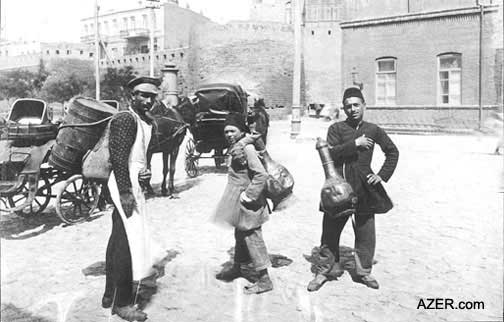
Above: Vendors selling water in the streets
of Baku. Early 1900s.
Dr. Ryszard Zelichowski, a Polish historian, was researching
the relationship between hygiene and city engineering in 19th-century
Warsaw when he discovered that the major water supply and sewage
systems had been designed by British engineer William Lindley
(1808-1900). Through extensive research, he learned of the eldest
son's connection with waterworks in Baku.
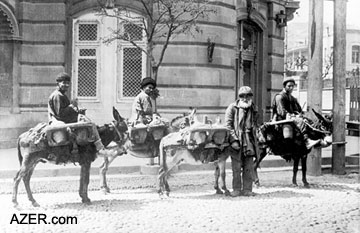  Left: Water vendors in Baku's streets before Shollar
Water system was installed in 1917. Left: Water vendors in Baku's streets before Shollar
Water system was installed in 1917.
Zelichowski's study
is, in fact, part of a growing body of literature referred to
as "Euro-Biography". His research identifies two major
trends in Victorian engineering: (1) the incredible progress
made by Western civilization, thanks to the ingenuity of these
engineers in designing filtration systems for drinking water
and in creating indoor plumbing, and (2) the profound legacy
of these engineers as the first "true" Europeans who
became deeply engaged in multiculturalism for the benefit of
the entire region. In today's lingo, we might have called them
"Engineers Without Borders".
Here Zelichowski describes Baku's struggles to find a reliable,
sufficient water supply, which Lindley himself described as "one
of the most challenging projects he ever undertook in his entire
life."
______
On January 28, 1899, the Baku
Commission for Water Supply informed the provincial Baku Duma
(Russian for "parliament") that it was seeking a project
to provide a sewage and water supply system for the city. This
water supply system would use the vast resources of water from
the Samur and Kur rivers, enough to supply the city with 3 million
buckets of water per day.
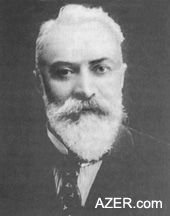  Left: Sir William H. Lindley. Left: Sir William H. Lindley.
With that goal in mind,
the Commission applied to three different European civil engineers;
one of them was William Heerlein Lindley (1853-1917). Lindley
and his family were known throughout Europe for their feats of
civil engineering. After beginning their activities in Germany,
they had expanded to more than 30 cities in Central and Eastern
Europe.
Lindley responded to the Duma's letter on June 3, 1899. Accepting
his conditions, the Duma sent a cable inviting him to come to
Baku as soon as possible. Lindley arrived in October and stayed
there for two months.
During his visit, he went to the countryside to examine the geological
structure of the surroundings of Baku. He found that the Kur
River had the best water resources and was most suitable for
supplying the city. Unfortunately, it was 120 km from Baku, in
land that was densely populated. A project that connected to
the Kur River would require a sophisticated, expensive system
for transporting and filtering the water.
Shollar Springs
When Lindley reported his findings to the Duma on December 18,
1899, he suggested the possibility of getting water from the
Caucasus mountains, especially the area of the Gusar river and
the Gil forest. Assisted by a detachment of Cossacks, he had
visited two springs called Shollar and Fersali. There he had
found a large quantity of pure water that would meet the current,
and, what he thought would be the future, needs of Baku. Since
the springs originated at a high elevation, the water could flow
for 40 km due to the sheer force of gravity.
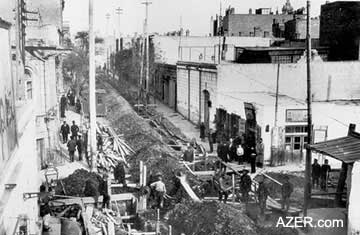 Right: Shollar Water Early 1900s. Above: Laying
of the water pipes through Balakhan (now Fizuli) street. Right: Shollar Water Early 1900s. Above: Laying
of the water pipes through Balakhan (now Fizuli) street.
Lindley's next visit to Baku was in May 1901. After a well-prepared,
professional lecture to the members of Duma, he convinced the
government to let him proceed with the project.
On June 23, 1901, the contract was ratified. For the entire design
and execution of the waterworks, Lindley was offered the handsome
sum of 35,000 rubles. Of this amount, 25,000 rubles had been
offered by Azerbaijani oil baron and philanthropist Haji Zeynalabdin
Taghiyev (1823-1924).
Lindley's project was scheduled to begin on January 1, 1902.
In the meantime, city mayor A. I. Novikov embarked on a long
journey to Western Europe to visit the water supply enterprise
in Frankfurt, Germany, which had been designed and supervised
by Lindley and his father, William Lindley (1808-1900). After
visiting the water plant, Novikov became a strong admirer of
the spring intake. When he returned to Baku, he insisted that
Lindley include both underground and spring intakes in his water
supply project.
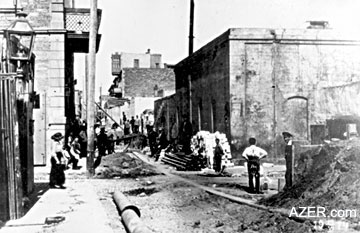  Left: Surakhan (now Dilara Aliyeva) Street. Left: Surakhan (now Dilara Aliyeva) Street.
By the autumn of 1903,
two of Lindley's representatives had arrived in Baku with the
plans for the final project in their hands. The pipeline would
tap the Kur and Samur rivers, with intakes located at a distance
of 125 and 170 km from Baku. Formalities concerning the contract
were completed on October 23 that year. Drilling works were assigned
to a French company, under Lindley's supervision. At last, the
real work began on January 3, 1904.
Revolution Slows
Work
The revolutionary events in Russia (1905-1907) had a negative
impact on the waterworks project in Baku, causing it to be delayed.
This revolution is often recognized as the first revolution of
the industrial era in Europe. It began on the so-called "Bloody
Sunday" in St. Petersburg (January 22, 1905) and resulted
in a wave of solidarity strikes sweeping through the industrial
regions of the Empire. The impact was not felt in Baku until
1906, when the second wave of revolutionary action by soldiers
and sailors took place. These events in June 1907 let to the
dissolution of Russia's Second State Duma.
At the time, the Duma journal "Izvestia Bakinskoy Gorodskoy
Dumy" stated: "The bloody events in Baku entirely paralyzed
the economy, stopping work on the city's water supply."
Only after N. V. Rayevsky was appointed as the new city leader
in 1908 was Lindley able to resume work once again.
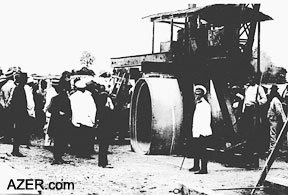  In the meantime, Baku's problems grew
more acute. Outbursts of cholera in 1907, 1908, 1909 and 1910
spread fear among the populace. These outbreaks were related
to the poor quality of the water supply and sewage system. Baku
residents had even developed two different words for good water
and bad water. Lindley reported that they called the impure water
"gara su" (literally, black water) and the pure water
"agh su" (white water). In the meantime, Baku's problems grew
more acute. Outbursts of cholera in 1907, 1908, 1909 and 1910
spread fear among the populace. These outbreaks were related
to the poor quality of the water supply and sewage system. Baku
residents had even developed two different words for good water
and bad water. Lindley reported that they called the impure water
"gara su" (literally, black water) and the pure water
"agh su" (white water).
Biggest project
Lindley often spoke about the difficulties of fulfilling such
a major project to supply Baku with water. He is reported as
saying, "In Western Europe alone, I have carried out water-pipe
and sewerage constructions in 35 cities. But I have never had
to deal with a work of such technical grand scale and difficulty
as the construction of this water pipe."
Above:
Pipeline for Shollar Water
brought water from the Caucasus mountains, 170 km from Baku.
Made of porcelain, it was the longest water pipeline for its
time in Europe or Russia. Completed 1917.
The 1912 edition of Illustrated London News praised Lindley's
achievements in an article entitled, "Water for a Great
Oil City: Building the Longest Conduit in Europe": "The
construction of reservoirs and a conduit for the supply of water
to the city of Baku constitutes an engineering feat without parallel
not only in Russia but also in Europe. It is the scheme designed
by and being carried out under the direction of Sir William H.
Lindley, M.Inst.C.E., F.C.S., whose works during the last 40
years have made his name famous throughout almost every country
on the Continent.Construction of the Baku Waterworks will form
an engineering feat, consisting as it does of the making and
laying of a conduit over a distance of 110 miles (the longest
pipeline in Europe) at the hitherto unprecedented rate of one
mile per week. The pipeline will be large enough for a man to
walk through, and is guaranteed to convey 25 tons per meter,
as a minimum load."
Despite the onset of World War I, work on the pipeline continued.
The demand for water in the city grew steadily as well.
According to the Duma journal, Lindley paid his last visit to
Baku in January 1916. On January 18, he delivered a lecture on
the prospect of supplying the industrial regions of Binagadi
and Surakhani with water from the Shollar intake. During that
visit, the city of Baku granted him honorary citizenship. This
was the last document that confirms anything about the journey
of Sir William H. Lindley to what was then a remote part of the
Russian Empire. News from the frontlines, then the Bolshevik
Revolution, meant the end of the world that he knew. Lindley
passed away peacefully in December 1917, of a stroke, in his
home in London, at the age of 64. Today the Shollar water system
is still considered to be the best water source for central Baku
both because of its superior quality and dependability of distribution.
Dr. Ryszard Zelichowski is a
historian with the Institute of Political Studies of the Polish
Academy of Sciences in Warsaw, Poland. He has published a number
of articles and a book (in Polish) on the Lindley family's activities
in Warsaw and other countries. His most recent book is a 450-page
biography of the Lindleys, in Polish, focusing on three geographic
areas: England, Germany and the Russian Empire (including St.
Petersburg and Baku). Contact him via e-mail at rzeli@omega.isppan.waw.pl.
For more information about the Shollar water pipeline, see "Shollar
Water: A Century Later" in AI
7.3 (Autumn 1999). SEARCH at AZER.com.
____
Back to Index
AI 10.2 (Summer 2002)
AI Home
| Magazine
Choice
| Topics
| AI Store | Contact us
Other Web sites
created by Azerbaijan International
AZgallery.org | AZERI.org | HAJIBEYOV.com
|





 Right: Shollar Water Early 1900s. Above: Laying
of the water pipes through Balakhan (now Fizuli) street.
Right: Shollar Water Early 1900s. Above: Laying
of the water pipes through Balakhan (now Fizuli) street.
